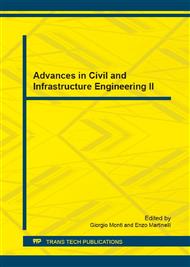[1]
HMSO. Statutory Instrument 1976, No. 1676: Building and Buildings. London: Her Majesty's Stationery Office, 1976, pp.1-102.
Google Scholar
[2]
GSA. Progressive collapse analysis and design guidelines for new federal office buildings and major modernization projects. Washington D. C.: United States General Services Administration, 2003, pp.1-96.
Google Scholar
[3]
DOD. Unified facilities criteria design of buildings to resist progressive collapse. Washington D. C.: Department of Defense, 2010, pp.1-98.
Google Scholar
[4]
A. Astaneh. Progressive Collapse Prevention in New and Existing Buildings. Proceedings of the 9th Arab Structural Engineering Conference, November (2003).
Google Scholar
[5]
B. El-ariss. Stiffness of reinforced concrete beams with external tendons. Engineering Structures, Vol. 26, 2004, p.2047–(2051).
DOI: 10.1016/j.engstruct.2004.04.009
Google Scholar
[6]
J.S. Du, F.T.K. Au, Y.K. Cheung, A.K.H. Kwan. Ductility analysis of prestressed concrete beams with unbonded tendons. Engineering Structures, Vol. 28, No. 1, 2008, p.13–21.
DOI: 10.1016/j.engstruct.2007.02.015
Google Scholar
[7]
C.K. Ng, K.H. Tan. Flexural behavior of externally prestressed beams. Part 1: analytical model. Engineering Structures, Vol. 28, No. 4, 2006, p.609–621.
DOI: 10.1016/j.engstruct.2005.09.015
Google Scholar
[8]
C.K. Ng, K.H. Tan. Flexural behavior of externally prestressed beams. Part II: experimental investigation. Engineering Structures, Vol. 28, No. 4, 2006, p.622–633.
DOI: 10.1016/j.engstruct.2005.09.016
Google Scholar
[9]
M. Garlock, J.M. Ricle, R. Sause. Influence of design parameters on seismic response of post-tensioned steel MRF systems. Engineering Structures, Vol. 30, No. 4, 2008, p.1037–1047.
DOI: 10.1016/j.engstruct.2007.05.026
Google Scholar
[10]
M. Kaya, A.S. Arslan. The effect of the diameter of pre-stressed strands providing the post-tensioned beam-to-column connections. Materials & Design, Vol. 30, No. 7, 2009, p.2604–2617.
DOI: 10.1016/j.matdes.2008.11.012
Google Scholar
[11]
J. Kim, W. Shin. Retrofit of RC frames against progressive collapse usingprestressing tendons. The Structural Design of Tall and Special Buildings, DOI: 10. 1002/tal. 691, 2011, pp.1-13.
DOI: 10.1002/tal.691
Google Scholar
[12]
W.J. Yi, Q.F. He, Y. Xiao. Collapse performance of RC frame structure. Journal of Building Structures, Vol. 28, No. 5, 2007, pp.104-109.
Google Scholar
[13]
Q.F. He, W.J. Yi. Experimental study of the collapse-resistant behavior of RC beamcolumnsub-structures considering catenary action. China Civil Engineering Journal, Vol. 44, No. 4, 2011, pp.52-59.
Google Scholar
[14]
F.W. Li, Y. Xiao, Y.B. Zhao, S. Kunnath, S.H. Lew. Experimental and analytical study on progressive collapse of RC frame with sudden side column removal. China Civil Engineering Journal, Vol. 47, No. 4, 2014, pp.9-18.
Google Scholar
[15]
G. Du, X. Tao. Ultimate stress of unbounded partially prestresses concrete beams. PCI Journal, Vol. 30, No. 6, 1985, pp.72-91.
DOI: 10.15554/pcij.11011985.72.91
Google Scholar
[16]
N. Burns, F. Charney. Test of one-way post-tensioned slabs with unbounded tendons. PCI Journal, Vol. 24, No. 6, 1978, pp.67-83.
DOI: 10.15554/pcij.09011978.66.83
Google Scholar
[17]
D. Branson, H. Torst. Application of a effective method in calculating deflections of partially prestressed members. PCI Journal, Vol. 28, No. 5, 1982, pp.63-77.
DOI: 10.15554/pcij.09011982.62.77
Google Scholar
[18]
J. Du, X. Liu. Research on the variations of unbounded prestressed tendon stresses based upon the structural deformation. China Civil Engineering Journal, Vol. 36, No. 8, 2003, pp.12-19.
Google Scholar


